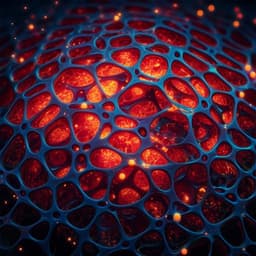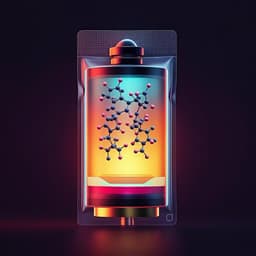
Engineering and Technology
Delocalized electronic engineering of TiNb<sub>2</sub>O<sub>7</sub> enables low temperature capability for high-areal-capacity lithium-ion batteries
Y. Zhang, Y. Wang, et al.
This groundbreaking research by Yan Zhang and colleagues uncovers how modulation of TiNb2O7's electronic states through dopants and oxygen vacancies can significantly enhance low-temperature performance in lithium-ion batteries. Achieving a competitive capacity of 1.32 mAh cm−2 at −40 °C, their findings promise to elevate battery efficiency even in extreme conditions.
~3 min • Beginner • English
Introduction
High areal capacity is essential for commercial LIBs with high energy density, requiring high mass loading of active components. Thick electrodes increase ion/electron transport distance and resistance, leading to polarization and low utilization, which worsen below 0 °C due to decreased electrolyte conductivity, hindered desolvation, and reduced solid-state Li+ diffusion. Graphite anodes suffer from increased polarization and risk of Li plating at low temperature and high rates, causing capacity loss and safety concerns. TiNb2O7 (TNO) anodes, operating near 1.65 V vs Li/Li+, offer safer lithiation potentials and open channels for Li+ migration due to defective ReO3-like structures. However, TNO’s large bandgap and poor electronic conductivity limit first Li+ insertion and cause voltage polarization, particularly at low temperature and fast charge, constraining areal capacity and low-T performance (< −30 °C). The apparent Li+ diffusion rate depends on intrinsic structure and particle size; nano-engineering shortens diffusion paths but reduces tap density, impairing volumetric energy density. This work targets a practical route to enhance charge-transfer kinetics in micron-sized TNO for high-areal-capacity, low-temperature batteries by delocalized electronic engineering via N incorporation and O vacancies in compact nanosheet-assembled microflowers, aiming to facilitate electron/ion transport, improve Li+ adsorption, and reduce diffusion barriers.
Literature Review
Prior studies highlight challenges for thick, high-loading electrodes due to increased tortuosity and transport resistance (e.g., refs 1–4). Low-temperature operation exacerbates electrolyte and interfacial limitations, and graphite anodes face severe polarization and Li plating risks (refs 5–10). Niobium-based oxides, including TiNb2O7, have been explored for safer potentials and fast-charging potential (refs 11–13, 16–18), yet large bandgaps and poor conductivity hinder low-T performance (refs 14–15). Nano-engineering improves kinetics but lowers tap density and volumetric energy (refs 17–19). Defect and anion engineering (e.g., O vacancies, dopants) can tune electronic states and enhance pseudocapacitive contributions and Li+ transport (refs 20–21, 23, 26–30). Partial nitridation of niobium/titanium oxides has previously improved rate performance (ref 30). Nevertheless, Li-storage behavior of high-mass-loading TNO-based electrodes below −30 °C and explicit correlations between intrinsic electronic structure and low-T properties have remained insufficiently reported.
Methodology
Materials synthesis: A TNO precursor was synthesized hydrothermally by combining NbCl5/oxalic acid aqueous solution and tetrabutyl titanate/oxalic acid ethanol solution with NH4F, reacted at 180 °C for 12 h, washed, and dried. The precursor was annealed at 750 °C (4 h) to obtain TNO. Nitriding was performed under Ar/NH3 at 700 °C for 1 h to yield nitrided TNO microflowers (TNO@N, denoted TNOx@N). A bulk solid TNO was prepared by mixing Nb2O5 and TiO2 and calcining at 1225 °C for 20 h.
Characterization: XRD (with Rietveld refinement), Raman spectroscopy, XPS (including high-resolution core levels), XANES, EPR for oxygen vacancies, SEM/TEM/HRTEM, aberration-corrected STEM-HAADF/ABF with EDS mapping, BET/BJH surface and porosity analyses, synchrotron nano-CT and 3D tomography.
Electronic/optical measurements: Ultrafast femtosecond transient absorption spectroscopy (pump 3.55 eV; WLC probe 430–820 nm) to probe carrier dynamics and polaron behavior. UV–vis diffuse reflectance for bandgap estimation.
Electrochemistry: Coin cells with Li metal counter/reference; electrolyte EC:DEC:DMC (1:1:1) with 1 M LiPF6. Regular electrodes (1.5 mg cm−2, 8:1:1 active:Super P:PVDF) and high-loading electrodes (up to 20 mg cm−2, 9:0.5:0.5). Galvanostatic cycling/rate tests at various temperatures (25 to −40 °C). EIS (temperature-dependent for activation energy), CV at multiple scan rates for b-value and capacitive contribution, GITT for apparent diffusion coefficients. Contact angle measurements for wettability. Pouch cells assembled with LiNi0.8Co0.1Mn0.1O2 cathodes; performance at varying C-rates and temperatures; IR thermal imaging.
Modeling and computation: Finite element simulations (COMSOL) to compare Li+ concentration distributions in solid spheres vs nanosheet microflowers under lithiation at 5–15 C, with Butler–Volmer kinetics and Nernst–Planck transport. DFT (VASP, GGA-PBE, PAW, 450 eV cutoff) to evaluate N substitution energetics, O-vacancy formation energies at various concentrations, electron localization functions (ELF), DOS/PDOS, Li+ adsorption energies (EC-solvated Li), Li migration pathways and energy barriers (CI-NEB). In situ XRD during cycling (0.25 C) with Rietveld refinement for lattice parameters and phase evolution; ex situ XPS at different states of charge; ex situ TEM/EDS at discharged/charged states.
Key Findings
- Structure and defects: TNOx@N retains monoclinic TiNb2O7 phase with XRD peak shifts to lower angles; unit cell volume increases from 795.316 Å3 (TNO) to 796.175 Å3 (TNOx@N). Raman shifts indicate decreased Nb/Ti–O bond symmetry. XPS/XANES/EPR confirm successful N incorporation, charge redistribution (∼0.2 eV blue shift in Nb 3d, Ti 2p), and increased oxygen vacancies (O vacancy/lattice O ratio 0.24 vs 0.12 in TNO; EPR g = 2.003 pronounced in TNO@N).
- Morphology: Nanosheet-assembled microflowers (2–3 μm, nanosheets ~300 nm) with mesoporosity (20–40 nm), higher surface area (BET 26.42 m2 g−1 vs 20.76 m2 g−1 for TNO), and an ~8 nm amorphous/nitrided surface layer.
- Electronic structure and conductivity: DFT shows impurity bands between valence and conduction bands due to N incorporation; narrowed bandgap (UV–vis: 2.62 eV vs 2.95 eV). ELF indicates increased electron delocalization. Powder electronic conductivity increases to 1.47×10^3 S cm−1 for TNOx@N vs 4.29×10^−8 S cm−1 for TNO (chronoamperometry).
- Li+ adsorption and diffusion: O p-band center upshift (−1.47 eV vs −2.19 eV), enhancing adsorbate interaction. Stronger Li+–EC adsorption on TNOx@N (Eads = −3.77 eV) vs TNO (−3.61 eV). DFT CI-NEB shows reduced Li migration barriers with N incorporation and further decrease with increasing O-vacancy concentration.
- Ultrafast dynamics: TA shows bandgap narrowing signature and increased polaron-related signals. Carrier lifetime τ2 increases from 14.85 to 30.22 ps with N incorporation (oxygen-defect-assisted recombination). Polaron formation time τ1 increases slightly (1.06 to 1.52 ps). Enhanced polaron concentration and lowered polaron hopping activation energy correlate with ~5-order increase in conductivity.
- Finite element simulations: Microflower architecture yields more homogeneous Li+ concentration and better utilization at high C-rates vs solid spheres, especially under high-rate conditions.
- Electrochemical performance (room temperature): At 0.5 C, TNO@N delivers 254.7 mAh g−1 with 93.0% retention over 130 cycles, outperforming TNO flower and solid TNO. At 1 C, 257.4 mAh g−1 with 0.0104% decay per cycle over 300 cycles. High-rate capability up to 60 C with 186.7 mAh g−1; capacity recovers when rate returns to 0.2 C. Prolonged cycling at 10 C shows 184.4 mAh g−1 after 1000 cycles. Mixture G/TNO@N (1:1) shows 273.4 mAh g−1 with 100% retention over 50 cycles.
- High-loading electrodes: At 10 mg cm−2, 1 C, room temperature, TNO@N shows 185.9 mAh g−1 with 82.3% retention after 250 cycles, surpassing controls. At 20 mg cm−2, areal capacity reaches 4.4 mAh cm−2 (0.2 C), retaining 3.35 mAh cm−2 after 80 cycles.
- Low-temperature performance: At −20 °C, TNO@N achieves 229.0 mAh g−1 with 99.8% retention after 70 cycles (0.5 C). At −30 °C, 215.4 mAh g−1 after 70 cycles; at 6 mg cm−2, 212.5 mAh g−1 at 0.2 C (75.4% of room temperature capacity). High-rate at −30 °C with 154.4 mAh g−1 (5 C) and 147.6 mAh g−1 (6 C) at 6 mg cm−2. At −30 °C and 10 mg cm−2, stable capacity 149.3 mAh g−1 with 92.9% retention after 250 cycles (1 C). At −40 °C and 12 mg cm−2, areal capacity 1.32 mAh cm−2; at 20 mg cm−2, initial areal 3.14 (−30 °C) and 2.36 mAh cm−2 (−40 °C) at 0.1 C; after 50 cycles at 0.2 C, 2.57 and 1.86 mAh cm−2, respectively.
- Diffusion coefficients and kinetics: GITT DLi+ at 25 °C for TNOx@N: 4.0×10^−13 cm2 s−1 (lithiation) and 6.2×10^−13 cm2 s−1 (delithiation), higher than controls. At −40 °C: 1.6×10^−14 (lithiation) and 2.6×10^−14 cm2 s−1 (delithiation), still exceeding TNO/solid TNO. EIS-derived activation energy for interfacial processes: 24.62 kJ mol−1 (TNOx@N) vs ~40.6 kJ mol−1 (TNO, solid TNO). High capacitive contributions: up to 84.7% at 0.6 mV s−1 (regular) and 78–82% (high-loading).
- Wettability and microstructure: Contact angles: solid TNO 24.3°, TNO 17.8°, TNO@N 10.6°, indicating improved electrolyte wettability. 3D tomography shows AM volume fraction 27.4% and continuous carbon/binder and pore network enabling efficient transport pathways.
- In situ/ex situ structural evolution: Reversible peak shifts in in situ XRD with weakened lattice anisotropy in TNO@N; three-stage phase evolution (M1 solid-solution; M2 two-phase; M3 solid-solution). Smaller unit-cell volume change at full lithiation vs TNO, indicating alleviated strain. Ex situ XPS shows Nb5+ to Nb4+ reduction during discharge and partial reversibility; ex situ TEM/EDS confirm structural reversibility.
- Pouch cells: TNO@N||NMC811 pouch cells (1.0–3.0 V) deliver 228.2 mAh g−1 at 0.2 C; maintain capacities across 0.3–15 C and 177.6 mAh g−1 at 0.5 C over 110 cycles. A 3.5 Ah-level pouch cell shows 3.32 Ah after 55 cycles (97.6% retention) at 0.5 C; at −30 °C retains 2.05 Ah after 80 cycles. Estimated energy densities: 271.6 Wh kg−1 and 373.4 Wh L−1 at 25 °C; 168.4 Wh kg−1 and 231.5 Wh L−1 at −30 °C. Thermal imaging indicates stable heat distribution across rates.
Discussion
The study addresses the core challenge of low-temperature operation and high areal capacity by simultaneously engineering electronic structure and mesoscale architecture. N incorporation and oxygen vacancies in TiNb2O7 generate impurity bands and electron delocalization that lower polaron hopping barriers, resulting in orders-of-magnitude higher electronic conductivity. DFT and TA spectroscopy consistently show enhanced carrier concentration, extended carrier lifetimes, and modulated polaron dynamics. These electronic effects, together with expanded interlayer spacings from anion engineering, reduce Li+ migration barriers and strengthen Li+ adsorption, promoting pseudocapacitive interfacial storage and faster kinetics at low temperature.
The nanosheet-assembled compact microflower morphology shortens diffusion pathways and increases electrode–electrolyte interfacial area while preserving tap density, as supported by finite element simulations showing uniform lithiation and better utilization at high rates. Electrochemical measurements confirm superior rate capability, long-term stability under high loadings, and strong low-temperature performance down to −40 °C. Improved wettability and a well-connected pore/CBD network further facilitate ion/electron transport. Collectively, these advances effectively mitigate polarization and transport limitations that typically degrade thick electrodes and low-temperature battery performance, enabling practical areal capacities and stable cycling.
Conclusion
This work demonstrates that delocalized electronic engineering via N incorporation and oxygen-vacancy formation in TiNb2O7 microflowers fundamentally improves low-temperature and high-areal-capacity lithium storage. The tailored electronic structure introduces impurity bands, enhances electron delocalization, lowers polaron hopping barriers, and strengthens Li+ adsorption, collectively accelerating charge transfer and Li+ diffusion. In concert with a compact nanosheet microflower architecture, the electrodes deliver high capacities and rate performance at room temperature and retain substantial areal capacities at −30 to −40 °C under high mass loadings. In situ/ex situ structural analyses reveal reversible phase evolution with reduced lattice anisotropy and smaller volume changes, supporting durability. These insights provide a rational design pathway—linking anion engineering, band structure modulation, and mesoscale architecture—to develop practical, fast-charging batteries for cold regions. Future work could optimize dopant/defect levels, scale electrode thickness/loading while maintaining uniform transport, and integrate electrolyte formulations tailored for ultra-low temperatures.
Limitations
Related Publications
Explore these studies to deepen your understanding of the subject.







